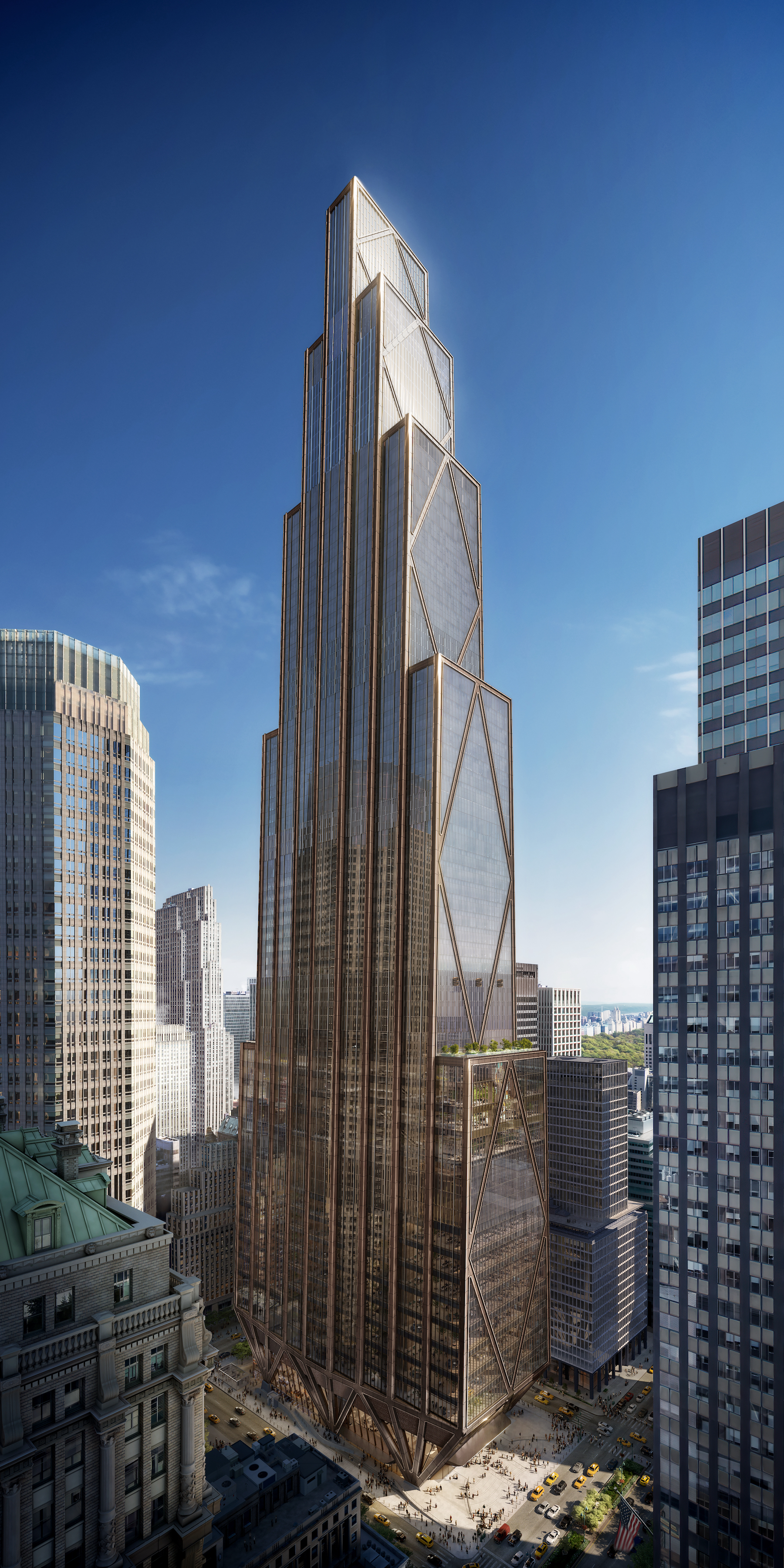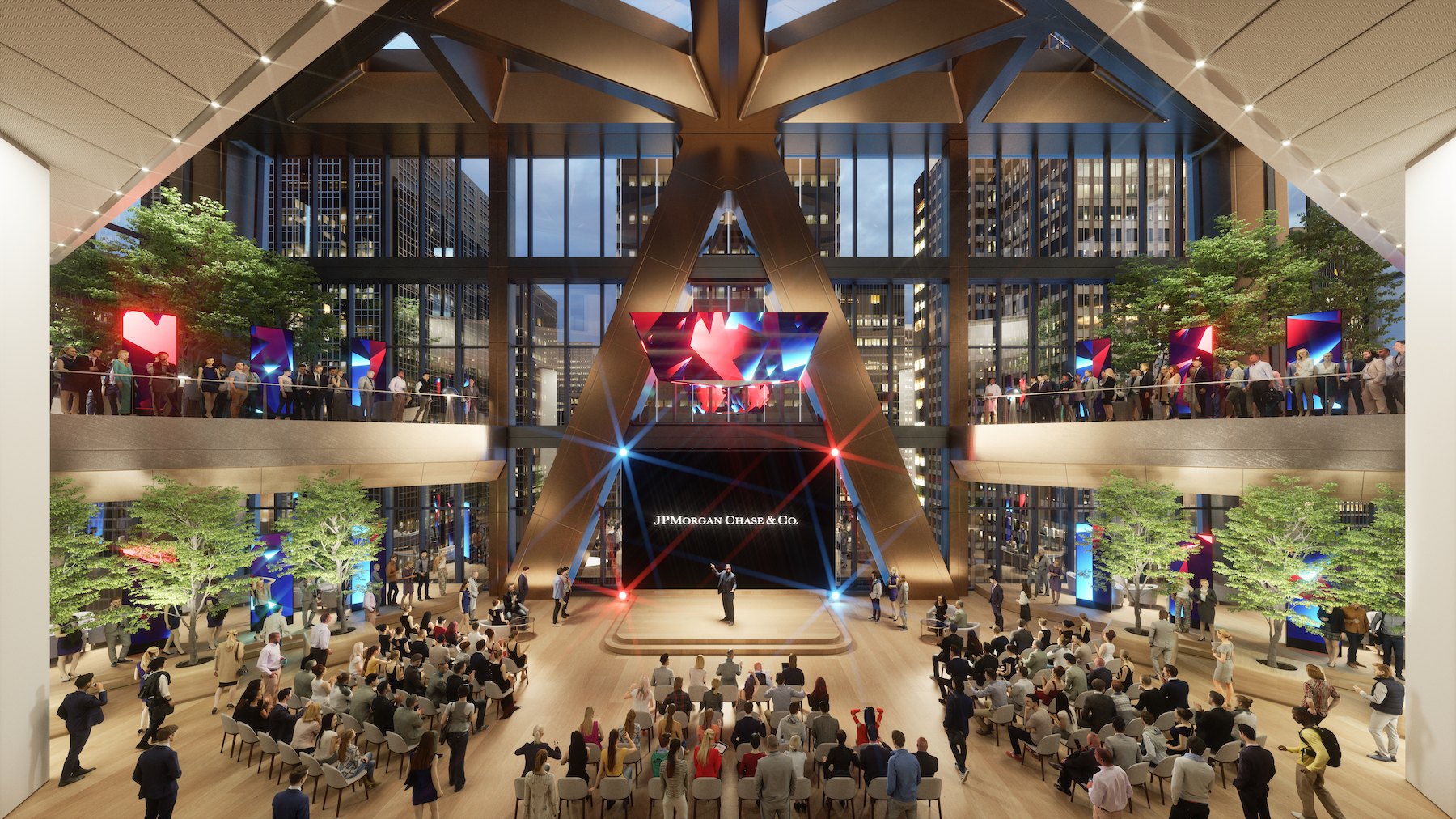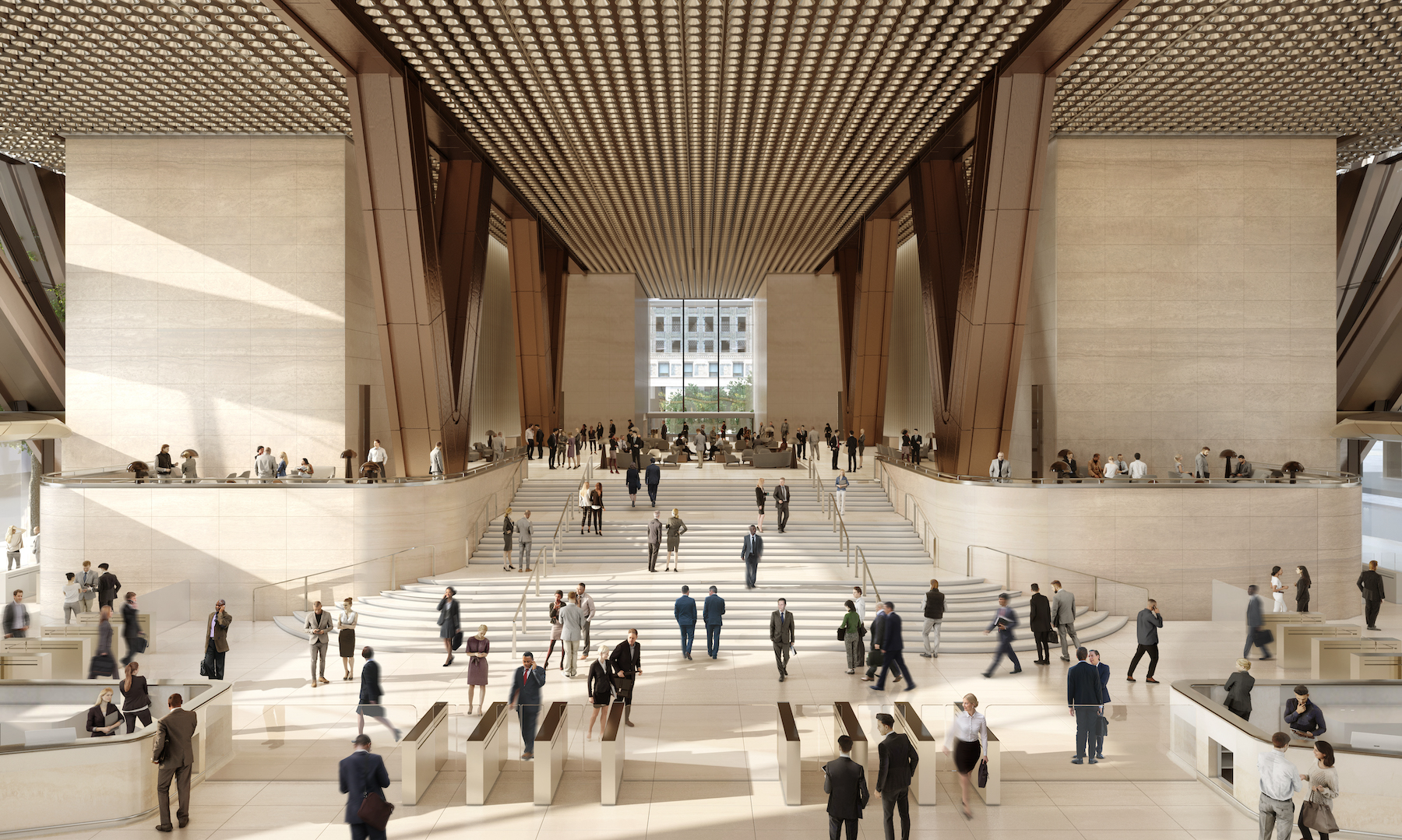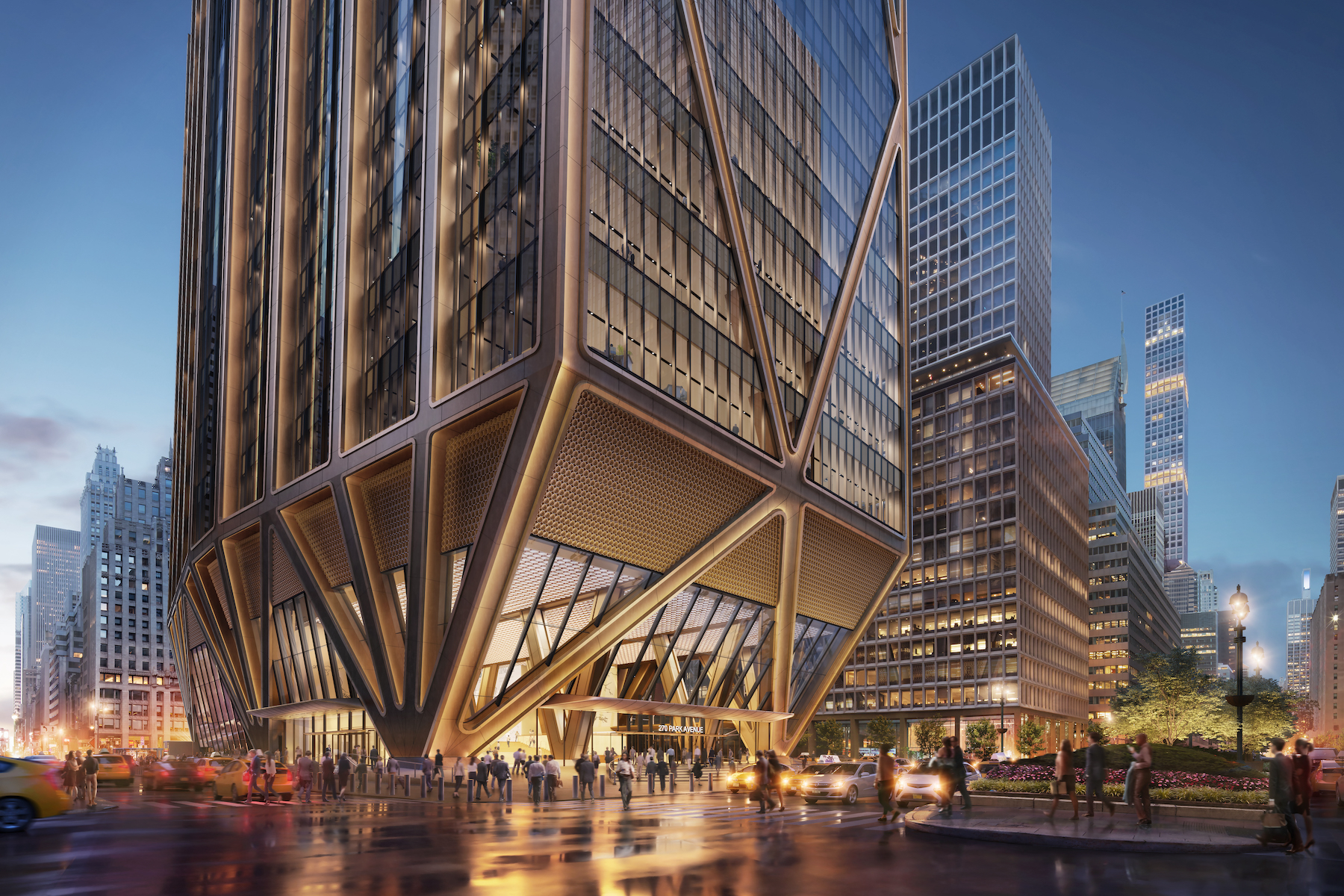JPMorgan Chase’s recently unveiled plans for its new global headquarters building in New York City that is rife with impressive sustainability credentials. The 1,388-foot, 60-story skyscraper will be a fully electric, net-zero operational emissions structure.
Designed by Foster + Partners, Chase’s headquarters at 270 Park Avenue will be New York City’s largest all-electric tower when completed by the end of 2025. It will have a capacity for up to 14,000 employees who will enjoy indoor air quality that exceeds the highest standards in sustainability, health, and wellness, according to a news release.
Using a state-of-the-art structural system to cope with site constraints below and at ground level, an innovative fan-column structure and triangular bracing will allow the building to touch the ground lightly across the entire block, the release says. The building will hover about 80 feet off the ground, extending the viewpoint from the Park Avenue entrance through to Madison Avenue. The property will feature an expansive public plaza with street-level green spaces.
Construction required that contractors thread the foundation of the new headquarters through Grand Central Station and the new Long Island Railroad Terminal below it. Inside, flexible column-free floor plates will allow for easily changeable layout and floor design, including inter-floor connections.
Designers strived for high health, wellness, and occupant comfort by:
- Doubling the amount of outside air and continuously monitoring air quality.
- Using advanced HVAC filtration systems to continually clean outdoor air while simultaneously cleaning recirculated air.
- Designing 50% more communal spaces and 25% more volume of space per person, giving more choices in where and how to work.
- Offering a state-of-the-art health and wellness center that will feature fitness areas, yoga/cycling rooms, physical therapy, medical services, modern mother’s rooms, and prayer and meditation spaces.
- Designing a large, modern food hall and a world-class conference center at the top of the tower.
- Creating a touchless journey for employees and visitors with more than 50,000 connected devices that will make it the most connected, data-driven high-rise building in New York City.
Environmentally friendly features include:
- Intelligent building technology that uses sensors, AI, and machine learning to predict and adapt to energy needs.
- Advanced water storage and reuse systems to reduce water use by more than 40%.
- Triple-pane glazing on the façade, and automatic solar shades connected to HVAC systems.
- Site will be 100% powered by renewable energy sourced from a New York State hydroelectric plant.
- The project recycled, reused, or upcycled 97% of the building materials from the demolition.
- Outdoor terraces featuring natural green space and plantings.
The project is the first under New York City’s Midtown East Rezoning plan that encourages modern office construction and improvements to the business district’s public realm and transportation system.
Owner and/or developer: JPMorgan Chase & Co.
Design architect: Foster + Partners
Architect of record: Adamson Associates
MEP engineer: Jaros, Baum & Bolles (JB&B)
Structural engineer: Severud Associates
General contractor/construction manager: Tishman Construction Company of New York



Related Stories
Urban Planning | Dec 18, 2023
The impacts of affordability, remote work, and personal safety on urban life
Data from Gensler's City Pulse Survey shows that although people are satisfied with their city's experience, it may not be enough.
Office Buildings | Dec 11, 2023
Believe it or not, there could be a shortage of office space in the years ahead
With work-from-home firmly established, many real estate analysts predict a dramatic reduction in office space leasing and plummeting property values. But the high-end of the office segment might actually be headed for a shortage, according to real estate intelligence company CoStar Group.
Market Data | Nov 27, 2023
Number of employees returning to the office varies significantly by city
While the return-to-the-office trend is felt across the country, the percentage of employees moving back to their offices varies significantly according to geography, according to Eptura’s Q3 Workplace Index.
Designers | Nov 6, 2023
DLR Group opens office in Nashville, Tenn.
DLR Group is expanding its presence in the Southeast with the opening of an office in downtown Nashville, Tenn.—a collaborative effort led by DLR Group Principals Matthew Gulsvig, AIA, LEED AP, and Randall Coy.
Office Buildings | Nov 2, 2023
Amazon’s second headquarters completes its first buildings: a pair of 22-story towers
Amazon has completed construction of the first two buildings of its second headquarters, located in Arlington, Va. The all-electric structures, featuring low carbon concrete and mass timber, help further the company’s commitment to achieving net zero carbon emissions by 2040 and 100% renewable energy consumption by 2030. Designed by ZGF Architects, the two 22-story buildings are on track to become the largest LEED v4 Platinum buildings in the U.S.
Biophilic Design | Oct 29, 2023
Natural wood floors create biophilic experience in Austrian headquarters office
100% environmentally friendly natural wood floors from mafi add to the biophilic setting of a beverage company office in Upper Austria.
Government Buildings | Oct 23, 2023
Former munitions plant reimagined as net-zero federal workplace
The General Services Administration (GSA) has embraced adaptive reuse with Building 48, an exciting workplace project that sets new precedents for how the federal government will approach sustainable design.
Office Buildings | Oct 19, 2023
Proportion of workforce based at home drops to lowest level since pandemic began
The proportion of the U.S. workforce working remotely has dropped considerably since the start of the Covid 19 pandemic, but office vacancy rates continue to rise. Fewer than 26% of households have someone who worked remotely at least one day a week, down sharply from 39% in early 2021, according to the latest Census Bureau Household Pulse Surveys.
Biophilic Design | Oct 18, 2023
6 ways to integrate nature into the workplace
Integrating nature into the workplace is critical to the well-being of employees, teams and organizations. Yet despite its many benefits, incorporating nature in the built environment remains a challenge.
Urban Planning | Oct 12, 2023
Top 10 'future-ready' cities
With rising climate dilemmas, breakthroughs in technology, and aging infrastructure, the needs of our cities cannot be solved with a single silver bullet. This Point2 report compared the country's top cities over a variety of metrics.

















